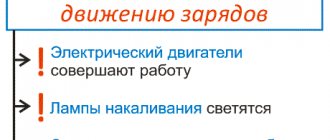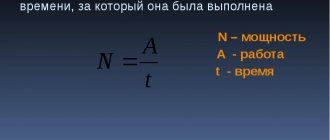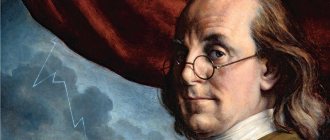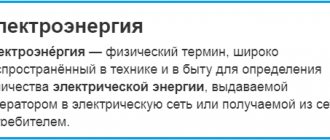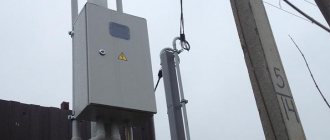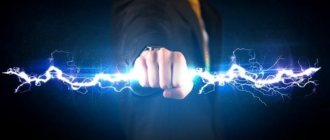What is electricity and where does it come from?
What do they think of when they hear the word “electricity” or “electric”?
Outlets, power lines, transformers or welders, lightning, batteries and chargers come to mind. Of course, there is a lot of electricity in modern civilization. Moreover, it exists in nature. But what do we know about him? Electricity is the process of movement of charged particles under the influence of an electromagnetic field:
- in one direction (direct current);
- with periodic changes of direction (alternating current).
The term is of Greek origin, and "electron" means 'amber'. It was first used by the ancient Greek philosopher Thales.
When we insert a plug into a socket, turn on an electric kettle or press a switch, an electrical circuit is closed between the source and receiver of electricity, thanks to which the electric charge gets a path to move, for example, along the spiral of the kettle. The process can be described as follows:
- The source of electricity is a socket.
- Electric current is an electric charge that moves through a conductor (for example, the spiral of a teapot).
- The conductor connects the socket to the consumer with two wires: along one of them the charge moves to the consumer, and along the second to the socket.
- In the case of alternating current, the wires change roles 50 times per second.
The source of energy for the movement of charges (that is, the source of electricity) in cities is power plants. They generate electricity using powerful generators, the rotor of which is driven by a nuclear installation or power plant (for example, a hydraulic turbine).
Power Lines: Freepick
Power plant transformers supply ultra-high alternating voltages of 110, 220, or 500 kilovolts to high-voltage power lines (PTLs). Having reached the step-down substations, it is reduced to the level of the household network - 220 volts. This is the voltage in our sockets, which we use every day, without thinking about the length of the path it travels.
Is it possible to store electricity for domestic purposes? Yes, we use this too. Conversion into chemical energy, namely batteries, helps with this. Chemical reactions between electrodes (substances and solutions that conduct current) create a current when the external circuit is closed to the consumer. The larger the electrode area, the more current can be obtained.
Using different electrode materials and the number of cells connected in the battery, different voltages can be generated. For example, in a lithium-ion battery, the standard voltage per cell is 3.7 volts. It works like this:
- Lithium ions with positive charges during the discharge move in the electrolyte from the anode (positive electrode) of copper and graphite to the cathode (negative electrode) of aluminum.
- During charging, a reverse movement occurs, and graphite-lithium compounds are formed, that is, energy is stored in the form of a chemical compound.
Such a battery operates fully for about 1000 charge-discharge cycles.
Battery: Freepick
In the modern world, everyone is accustomed to the fact that electricity is always available in the house. Thousands of people work every day to ensure that its sources operate smoothly.
Alternative energy sources
This category of energy sources usually includes solar rays, wind, subsoil, etc. Various generators focused on accumulating and converting solar energy into electricity are especially common. Such installations are attractive because they can be used by any consumer in the volumes required to supply his home. However, the wide distribution of such generators is hampered by the high cost of the equipment, as well as operational nuances caused by the dependence of working photocells on light intensity.
At the level of large energy companies, wind alternative sources of electricity are actively developing. Already today, a number of countries are using programs for a gradual transition to this type of energy supply. However, this direction also has its obstacles, due to the low power of generators and high cost. A relatively new alternative source of energy is the natural heat of the Earth. In this case, the stations convert thermal energy obtained from the depths of underground channels.
History of origin
Many years ago, people observed natural phenomena of an electrical nature. In 600 BC. In Greece, it was experimentally established that fossilized resin rubbed with wool attracts objects.
In the 30s In the 20th century, archaeologists found pots containing copper sheets. These peculiar lighting batteries were discovered in Baghdad, which suggests that the development belongs to the ancient Persians.
In 1600, the word electricus was used by William Gilbert to describe the static energy produced by the mechanical interaction of substances. Thomas Brown used the category “electricity” (“amber”) in a number of research works. From this time on, an era of experiments began in order to unravel the nature of the phenomenon. The date of each of them is written into history.
In the 17th century a generator was invented, insulators and conductors were classified, particles with “+” / “-” charges were differentiated. Since the 18th century and humanity still produces, generates and consumes electricity.
The period of early discoveries prepared the basis for the development of science, research, and the development of equipment for transporting electricity.
History of the invention of electricity
It would be wrong to say that one person discovered electricity. The idea itself existed for thousands of years, and then the era of scientific and commercial exploration began. Many great minds have worked on the question of the nature of electricity.
Thales of Miletus
Around 600 BC e. Greek mathematician Thales discovered that when fur rubs against amber, attraction arises between them. It turned out that it is caused by an imbalance of electrical charges, so-called static electricity.
William Gilbert
The concept of “electricity” was first introduced by William Gilbert in 1600. From that moment on, the date when electricity appeared was noted.
The English physicist wrote the book “De Magnete” in 1600. In it, the scientist explained the experiments conducted by Thales of Miletus. The phenomenon of static electricity, which the ancient researcher produced with the help of amber (in Greek 'electrum'), Gilbert called electric force.
This is how the English word electricity appeared. In addition, the scientist invented an electroscope that detected the presence of electrical charges on the body.
Otto von Guericke - the first electrostatic machine
In 1663, the German engineer, physicist and philosopher Otto von Guericke invented a device that was the prototype of an electrostatic generator. It was a ball of sulfur mounted on a metal rod, which was rotated and rubbed by hand. With the help of this invention, it was possible to see in action the property of objects not only to attract, but also to repel.
In March 1672, the famous German scientist Gottfried Wilhelm Leibniz, in a letter to Guericke, mentioned that while working with his machine, he recorded an electric spark. This was the first evidence of a phenomenon that was mysterious at that time. Guericke created a device that served as a prototype for all future electrical discoveries.
In 1729, British scientist Stephen Gray conducted experiments that revealed the possibility of transmitting electric charge over short (up to 800 feet) distances. He also established that electricity is not transmitted through the earth. Subsequently, this made it possible to classify all substances into insulators and conductors.
Charles Francois Dufay
At the beginning of the 17th century, a French scientist discovered two types of electricity. He called them glassy and resinous (in modern terminology - positive and negative charges). He discovered that objects with the same charges attract, and objects with opposite charges repel.
Charles Augustin de Coulomb - the law of interaction of charges
French engineer and physicist Charles Augustin de Coulomb in 1785 discovered a law that reflected the force of interaction between static point charges. Coulomb had previously invented the torsion balance. The emergence of the law took place thanks to Coulomb's experiments with these scales. With their help, he measured the force of interaction between charged metal balls.
We recommend reading: Switching power supply: what is it, principle of operation, circuit, purpose
Coulomb's law was the first fundamental law explaining electromagnetic phenomena, with which the science of electromagnetism began. A unit of electric charge was named in honor of Coulomb in 1881.
Pieter van Muschenbrouck - Leyden jar
In 1745, Dutch physicist Pieter van Muschenbrouck invented the Leyden jar, which became the first electrical capacitor.
Its creator is also the German lawyer and physicist Ewald Jürgen von Kleist. Both scientists acted in parallel and independently of each other. This discovery gives scientists every right to be included in the list of those who created electricity. On October 11, 1745, Kleist experimented with a “medicine jar” and discovered the ability to store large amounts of electrical charges. He then informed German scientists about the discovery, after which an analysis of this invention was carried out at Leiden University. Then Pieter van Muschenbrouck published his work, thanks to which the Leiden jar became famous.
Benjamin Franklin - two types of charges
Benjamin Franklin introduced the concept of charge polarity. Since then, it has been an axiom that any electrical potential has negative and positive poles.
In the mid-18th century, Benjamin Franklin conducted numerous experiments studying the nature of electricity. In 1748, he managed to build an electric battery from glass sheets compressed with lead plates. The scientist discovered the principle of charge conservation. In the summer of 1752, Franklin conducted a famous experiment that proved that lightning is electricity.
Luigi Galvani
This Italian physicist and biologist took the lead in the discovery of the phenomenon of bioelectromagnetism. In 1780, he conducted experiments on frogs and found that electricity is the medium through which neurons transmit signals to muscles.
Alessandro Volta - invention of the battery
This Italian physicist found that some chemical reactions are sources of direct electric current. He built an electric battery using copper and zinc to produce a continuous flow of electrical charges.
Volta introduced the concepts of electric potential (V) and charge (Q), and expressed the law of capacitance, later named after him. For this work, the unit of measurement of electric potential was named in his honor.
Documentary evidence of the invention of the electric battery is considered to be the device proposed by the Italian scientist Alessandro Volta. The device was called a voltaic column. It was a kind of whatnot, made of copper and zinc plates, arranged with pieces of felt moistened with a solution of sulfuric acid.
An electric potential was created at the top and bottom of the pillar, the discharge of which could be felt by placing the palms of the hands on the pillar. As a result of the interaction of metal atoms excited by the electrolyte, electricity accumulated inside the battery.
The inventor of galvanic electricity, Alessandro Volta, laid the foundation for what is today called batteries.
Hans Christian Oersted and Andre-Marie Ampere - the emergence of the concept of current
At the beginning of the 19th century, Danish physicist Hans Christian Oersted discovered a direct connection between electricity and magnetism. He described how a compass needle is deflected by an electric current.
Inspired by this work, French physicist André-Marie Ampère compiled a formula to describe the magnetic forces that arise between objects carrying current. A unit of measurement of electric current was named in his honor.
In 1821, the French mathematician, physicist and natural scientist Andre-Marie Ampère, in his own treatise, established a connection between magnetic and electrical phenomena, which is absent in the static nature of electricity. Thus, he first introduced the concept of “electric current”.
Ampere designed a coil with multiple turns of copper wires, which can be classified as an electromagnetic field amplifier. This invention served to create the electromagnetic telegraph in the 30s of the 19th century.
Thanks to Ampere's research, the birth of electrical engineering became possible. In 1881, in his honor, the unit of current was called the “ampere,” and instruments that measure force were called “ammeters.”
Georg Simon Ohm - the law of the electrical circuit
German physicist Georg Simon Ohm introduced a law in 1826 that proved the relationship between resistance, voltage and current in a circuit. Thanks to Om, new terms arose:
- network voltage drop;
- conductivity;
- electromotive force.
A unit of electrical resistance was named after him in 1960, and the Ohm is undoubtedly included in the list of those who invented electricity.
Michael Faraday - electromagnetic induction
The English chemist and physicist Michael Faraday made the discovery of electromagnetic induction in 1831, which underlies the mass production of electricity. Based on this phenomenon, he creates the first electric motor. In 1834, Faraday discovered the laws of electrolysis, which led him to the conclusion that atoms can be considered the carrier of electrical forces. Electrolysis studies played a significant role in the emergence of electronic theory.
This scientist:
- laid the foundation for the concept of the electromagnetic field;
- discovered that magnetism affects light rays;
- invented electromagnetic rotation devices.
In 1831, Faraday designed an electric dynamo in which rotary mechanical energy was continuously converted into electrical energy. This made it possible to produce electricity.
Thomas Edison
In 1879, a scientist invented a practical light bulb. Next, he set about developing a system that would provide people with a source of energy to power such lamps. In 1882, the first power station was built in London, which generated electricity and supplied it to people's homes.
A few months later, the first power plant appeared in New York, which supplied electricity to illuminate the lower part of Manhattan Island (85 consumers were able to light 5,000 lamps). It was direct current.
Nikola Tesla
Nikola Tesla Resonance in an electrical circuit
Nikola Tesla is an outstanding scientist who made a huge contribution to the study of this phenomenon. Tesla owns more than 1,000 different inventions, about 800 of which he patented.
Tesla is known for developing a new type of alternating current motor and electric power transmission technology. He patented an alternating current system to provide people with the highest quality electricity. Tesla's power systems spread to the United States and Europe, as they provided long-distance high-voltage transmission.
The most significant and important inventions of the great scientist are:
- High frequency generator;
- Induction asynchronous electric motor;
- High frequency transformer;
- Mast antenna for transmitting and receiving radio signals.
Tesla was also the first to develop and actively practice safety rules when working with electric current of various frequencies and strengths.
We recommend reading: Marking wires and cables: deciphering the factory markings on the insulation
Heinrich Rudolf Hertz and Albert Einstein
Heinrich Hertz was engaged in experiments on the study of electromagnetic waves. In 1887, he described the photoelectric effect, where electrons are emitted (stripped from an atom) when electromagnetic radiation (such as light) hits a material.
In 1905, Albert Einstein published the law of photoelectric effects and hypothesized light energy quanta. Thus began the development of quantum mechanics and the creation of solar cells.
Since electricity is necessary for humanity, research in this area continues today. We cannot imagine life without electric current, and scientists are in search of new sources of it.
Management of electric power facilities
In addition to the organization of the electrical grid, which technically provides the possibility of transmitting and distributing energy to end consumers, the operation of this complex is impossible without control systems. To implement these tasks, suppliers use operational control centers, whose employees implement centralized control and management of the work of the electric power facilities entrusted to them. In particular, such services control the parameters of networks to which electricity consumers are connected at different levels. Separately, it is worth noting the control center departments that perform network maintenance, preventing wear and tear and repairing damage in individual sections of lines.
Lighting
When did electricity appear in houses and apartments? For many, this phenomenon is primarily related to lighting. Therefore, it should be considered when the first light bulb was invented. This happened in 1809. The inventor was the Englishman Delarue. A little later, spiral-shaped light bulbs appeared, which were filled with inert gas. They began to be produced in 1909.
The advent of electricity in Russia
Some time after the introduction of the term “electricity,” this phenomenon began to be studied in many countries. The beginning of change can be considered the appearance of lighting. In what year did electricity appear in Russia? According to public outcry, this date is 1879. It was then that the Liteyny Bridge was first electrified using lamps in St. Petersburg.
But a year earlier in Kyiv, in one of the railway workshops, electric lights were installed. Therefore, the date of the appearance of electricity in Russia is a somewhat controversial issue. But since this event went unnoticed, the official date can be considered the lighting of the Liteiny Bridge.
But there is another version when electricity appeared in Russia. From a legal point of view, this date is January thirtieth, 1880. On this day, the first electrical engineering department appeared in the Russian Technical Society. His duties were to oversee the introduction of electricity into everyday life. In 1881, Tsarskoye Selo became the first European city to be completely illuminated.
Another significant date is May fifteenth, 1883. On this day, the Kremlin was illuminated for the first time. The event was timed to coincide with the accession to the Russian throne of Alexander III. To illuminate the Kremlin, electricians installed a small power station on Sofiyskaya Embankment. After this event, lighting first appeared on the main street of St. Petersburg, and then in the Winter Palace.
In the summer of 1886, by decree of the emperor, the Electric Lighting Society was established. It was engaged in the electrification of the entire St. Petersburg and Moscow. And in 1888, the first power plants began to be built in the largest cities. In the summer of 1892, the debut electric tram was launched in Russia. And in 1895 the first hydroelectric power station appeared. It was built in St. Petersburg, on the river. Bolshaya Okhta.
And in Moscow, the first power plant appeared in 1897. It was built on Raushskaya embankment. The power plant generated three-phase alternating current. And this made it possible to transmit electricity over long distances without significant loss of power. In other Russian cities, power plants began to be built at the dawn of the twentieth century, before the First World War.
Production and practical use
From the time of the first electricity to the mass production of electricity and its practical application, many discoveries and inventions must have occurred in the field of generating and transmitting electrical energy.
Application
It is almost impossible to name a sphere of human activity where electricity is not involved. It is the main source of energy in many life-supporting areas of human activity.
Electricity generation and transmission
Over time, they began to come up with various ways to generate electricity. With the advent of mobile, and subsequently giant power plants, the problem of transmitting electricity over long distances arose.
The scientific and technological revolution helped resolve this issue. As a result, huge power transmission networks were built, spanning countries and entire continents.
Electricity distribution
After the generation of electricity, the stage of its transmission and distribution begins, which is provided by energy supply companies. Resource suppliers organize the appropriate infrastructure, the basis of which is electrical networks. There are two types of channels through which electricity is transmitted - overhead and underground cable lines. These networks are the ultimate source and main answer to the question of where electricity comes from for various user needs. Supplier organizations lay special routes for organizing network distribution of electricity, using different types of cables.
AC and DC current
When electricity was discovered, a dispute broke out between Thomas Edison and Nikola Tesla over which current to use as the main one, alternating or direct. The confrontation between scientists was even nicknamed the “War of Currents.” Alternating current won this fight because it:
- easily transmitted over long distances;
- does not incur huge losses when transmitted over a distance.
Main areas of consumption
In everyday life, direct current is used quite often.
It powers various household appliances, generators and chargers. In industry it is used in batteries and engines. In some countries, power lines are equipped with it. Alternating current is capable of changing in direction and magnitude over a certain period of time. It is used more often permanently. In our homes, its source is sockets; various household appliances at different voltages are connected to them. Alternating current is often used in industry and street lighting.
Electric current in life
Nowadays, electricity comes to our homes thanks to electrical stations. They are equipped with special generators that operate from an energy source. This energy is mainly thermal, which is obtained by heating water. Oil, gas, nuclear fuel or coal are used to heat water. The steam produced by heating the water drives huge turbine blades, which in turn run a generator. To power the generator, you can use the energy of water falling from a height (from waterfalls or dams). Wind power or solar energy are less commonly used.
The generator then uses a magnet to create a flow of electrical charges through the copper wires. In order to transmit current over long distances, it is necessary to increase the voltage. For this role, a transformer is used to step up and step down the voltage. The electricity is then transmitted with high power through cables to the place where it is used. But before entering the house, it is necessary to reduce the voltage using another transformer. It is now ready to use.
When people start talking about electricity in nature, the first thing that comes to mind is lightning, but this is far from its only source. Even our bodies have an electrical charge; it exists in human tissues and transmits nerve impulses throughout the body. But not only humans contain electric current. Many inhabitants of the underwater world are also capable of generating electricity, for example, a stingray contains a charge of 500 watts, and an eel can create a voltage of up to 0.5 kilovolts.
We recommend reading: Series connection of conductors - diagrams, laws, forums
Not only a friend, but also an enemy!
Of course, electricity is an important and irreplaceable invention for all mankind. With its help people:
- they have made and are making a lot of discoveries every day;
- treat diseases that were fatal in the past;
- drive electric vehicles without polluting the environment with exhaust gases;
- can travel the world, learn and see sights without leaving home!
All the benefits of electricity simply cannot be described in one article!
But with all this, the current can be dangerous and in a split second take the life of any living creature.
By the way, an interesting fact. Birds that sit on high-voltage wires do not receive a shock due to the fact that they receive the same voltage as in the cable itself. The fact is that they sit only on one phase, but if suddenly the bird’s tail or other part of the body touches the ground, a pole or another wire, the current will immediately hit it.
Phenomena in nature associated with electricity
Nature is rich in electrical phenomena. Examples of such phenomena that are associated with electricity are the northern lights, lightning, etc.
Northern lights
The upper layers of the air shell often accumulate small particles arriving from space. Their collision with the atmosphere and dust causes a glow in the sky, which is accompanied by flashes. This phenomenon is observed by residents of polar regions. This phenomenon was called the aurora borealis. The northern glow sometimes lasts for several days, shimmering in different colors.
Lightning
Moving with atmospheric currents, cumulus clouds cause friction between droplets and ice crystals. As a result of friction, charges accumulate in the clouds. This leads to the formation of giant sparks between the clouds and the ground. This is lightning. They are accompanied by peals of thunder.
The accumulation of electrical charges in the air sometimes causes the formation of small glowing balls or large sparks. These balls and sparks are called ball lightning. They move with the air, exploding on contact with individual objects. Such lightning often causes burns and death of living beings and people, and fire of objects. Scientists cannot yet accurately explain the reasons for the appearance of lightning.
St. Elmo's Fire
This is the name for a phenomenon familiar to sailors sailing on sailboats since ancient times. They rejoiced when they saw the glow of the masts in bad weather. The sailors believed that the lights testified to the patronage of St. Elmo.
The glow can be observed in a thunderstorm on high spiers. The lights look like candles and brushes in a blue or light purple hue. The length of these lights sometimes reaches a meter. The glow is sometimes accompanied by a hissing or a soft whistle.
The sailors tried to break off part of the mast along with the fire. But this was never successful, since the fire “flowed” onto the mast and rose up it. The flame is cold, it does not ignite, it does not burn your hands. And it can burn for several minutes, sometimes for about an hour. Modern scientists have established that these lights are electrical in nature.
Metals are conductors of electricity
Metals serve as conductors of these same electrons (charged particles). They easily flow along the conductor from one section to another. While the electrons are moving, parallel physical phenomena occur. For example, when many electrons move in an orderly manner through a thin conductor, they collide with atoms that are stationary in their places in the crystal lattice of the substance. As a result of such collisions, the energy of electron motion is converted into heat energy of the atom with which the collision occurred. That is, the energy of electron motion partially converted into heat energy, heating the substance.
Electromagnetic fields
There is another example in which the essence of electricity is manifested. This is the interaction of electromagnetic fields. Let us remember that there is an electric field around stationary charged particles, and a magnetic field also arises around moving electric particles. As a result, when charged particles move around them, a general electromagnetic field is formed, and it affects other fields of other charged particles. An electric motor works on this principle. In simple words, magnetic fields cause an electric motor to rotate, and at this moment, electric charges flow from one pole to another through its windings.
Schematic diagram of the movement of electric charges from one pole to another
Modern round of research
A grandiose breakthrough in the development of electrical engineering was made by the legendary scientist, physicist and inventor Nikola Tesla at the turn of the 19th and 20th centuries. Many of Tesla's inventions are still awaiting a new round of research in the field of electrical engineering in order for them to be put into practice.
Currently, research is underway to obtain new superconducting materials and create advanced components for electrical circuits with high efficiency.
Additional Information. The discovery of graphene and the production of new conductive materials from it predict enormous changes in the use of electricity.
Science does not stand still. Every year, humanity witnesses the emergence of more advanced sources of electricity, along with the creation of devices, machines and various units that consume environmentally friendly energy in the form of electric current.
Interesting facts about electricity
- In order to extract electricity from a magnet from a speaker, two copper wires are wound around it, their two ends are soldered together, and a small light bulb or LED strip is connected to the remaining ones. In order to make a power source for a 220 V incandescent lamp, more powerful and larger magnets and thick copper wires of large cross-section are used.
- The oldest battery is considered to be a device found during excavations in Egypt, which is a copper vessel with an iron rod inserted into it that does not touch the walls.
- In order to show how electricity is generated and flows, at the court of King Louis XV they conducted an experiment with a Leyden jar and a formation of soldiers: the soldiers holding hands formed nothing less than the world's first full-fledged living electrical circuit;
- Due to the large number of deaths from lightning in Italy in the 18th century, a very strange fashion for hats and umbrellas with lightning rods appeared in many European countries;
- In Scandinavian countries, the main, and sometimes the only, source of electricity is hydroelectric power plants. Thanks to this, these countries have very low levels of air pollution.
Knowing how familiar electricity works is very important for every person, not only for the purpose of self-education and broadening one’s horizons, but also to ensure one’s own safety in a world where quite dangerous electricity is found at almost every step.
How does current make electrical appliances work?
But how does current manage to power electrical devices? For a visual understanding, let's take a regular incandescent lamp as a basis and return to our small particles.
As electrons travel at incredible speeds through the light bulb's spiral, they continually collide with the metal atoms that make up the spiral. The atoms wobble and their temperature rises greatly. Thus, the electric current heats the lamp spiral to 3000 degrees, causing it to begin to glow. This is why the use of any metal is not suitable for the spiral, because it will simply melt due to the high temperature.
Modern devices - mobile phones, TVs, microwave ovens - use more complex circuits, but the principle remains the same: due to the rapid flow of particles, the atoms of the conductors heat up, which releases energy and starts the devices to work.

